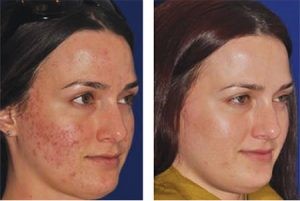
SkinPen is a safe, effective way to improve the skin’s tone and texture, reduce pigmentation and improve scars and stretch marks. Noticeable results include a reduction in the appearance of fine lines and wrinkles and younger-looking skin with fewer signs of aging. SkinPen also has a positive effect on hyper-pigmentation as well as on hypo-pigmentation, acne scars, traumatic scars and stretch marks and generally creates a fresher appearance or glow to the skin.
These treatments can be performed on all parts of the body including face, neck, décolleté, arms, hands, legs, abdomen and back. The procedure is performed by a licensed esthetician and takes 30 minutes to an hour or more, depending on the area. SkinPen uses tiny sterile needles to safely and precisely create controlled micro-injuries to the skin, triggering new collagen production.
FAQ’S ABOUT SKINPEN
What is this treatment and what is it used for?
SkinPen uses tiny sterile needles to safely and precisely create controlled micro-“injuries” in the skin which then trigger new collagen synthesis. It is used to improve skin tone and texture, reduce pigmentation, minimize wrinkles like crow’s feet and lip lines, and improve scars and stretch marks.
How many treatments are needed and when do you start to see benefits?
Typically a series of 3–5 treatments is performed for optimal results; however, each treatment will induce some collagen remodeling, and SkinPen can be used for ongoing maintenance.
Who will be performing the treatment?
Your esthetician.
How long does a treatment take?
Treatment time will vary depending on the surface area treated but typically will range from 15–30 minutes. Because a topical anesthetic may be applied ahead of time, plan to spend between 30–60 minutes in the office.
Does the treatment hurt?
Deeper SkinPen treatments can be slightly uncomfortable so a topical anesthetic will typically be applied ahead of time to reduce any discomfort. More superficial skin treatments are well-tolerated without any anesthetic.
What do I look like right after and how much downtime is there?
Immediately after a treatment the skin can appear flushed like a light sunburn to deeper pink with pinpoint bleeding for deeper treatments. Typically any redness will resolve within 1–2 days. Make-up can be applied immediately.
What are the possible side effects?
Mild discomfort and redness are common effects. Very rarely, treatments could lead to a cold sore reactivation or other infection, formation of granulomas (small bumps under the skin), permanent color change or scarring.
How do I prepare for the treatment?
Let your provider know if you have a history of cold sores or warts on the targeted area.
What is the aftercare?
Ice packs or cool compresses can be used to soothe the skin. Practice good sun protection by using sunscreen and avoid abrasive topicals or treatments for 2–3 days.
Are there any contraindications to having the treatment done?
You should not have a microneedling treatment if you have vitiligo, have an active skin infection (such as flat warts or a cold sore), or have taken isotretinoin within the past 6 months. Please notify your provider if you are prone to excessive/keloid scarring or have a collagen vascular disease such as lupus.
If you’re a good candidate for microneedling, it’s a safe and effective way of minimizing pigmentation problems, reducing the appearance of crow’s feet and lip lines, and generally improving skin tone and texture without surgery.